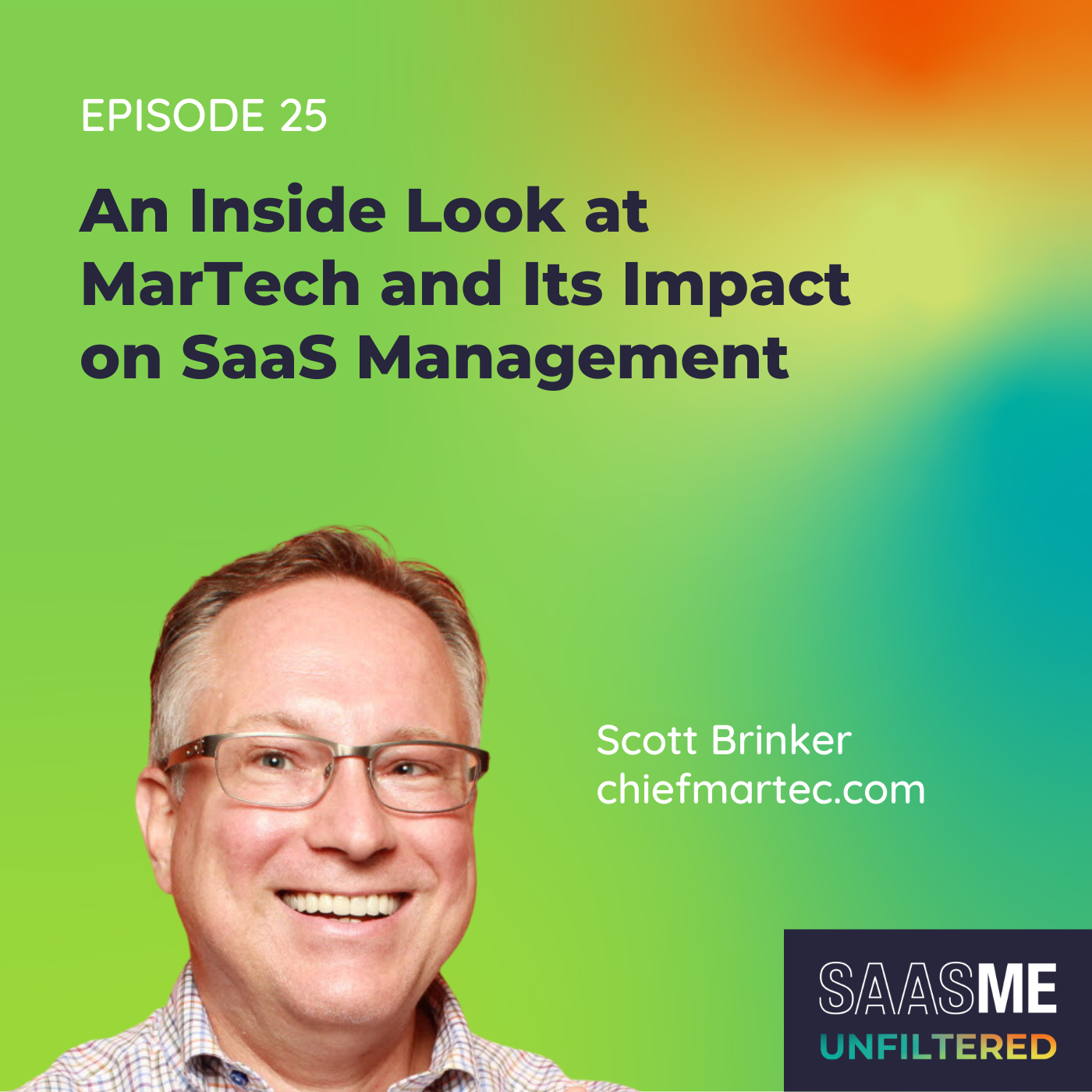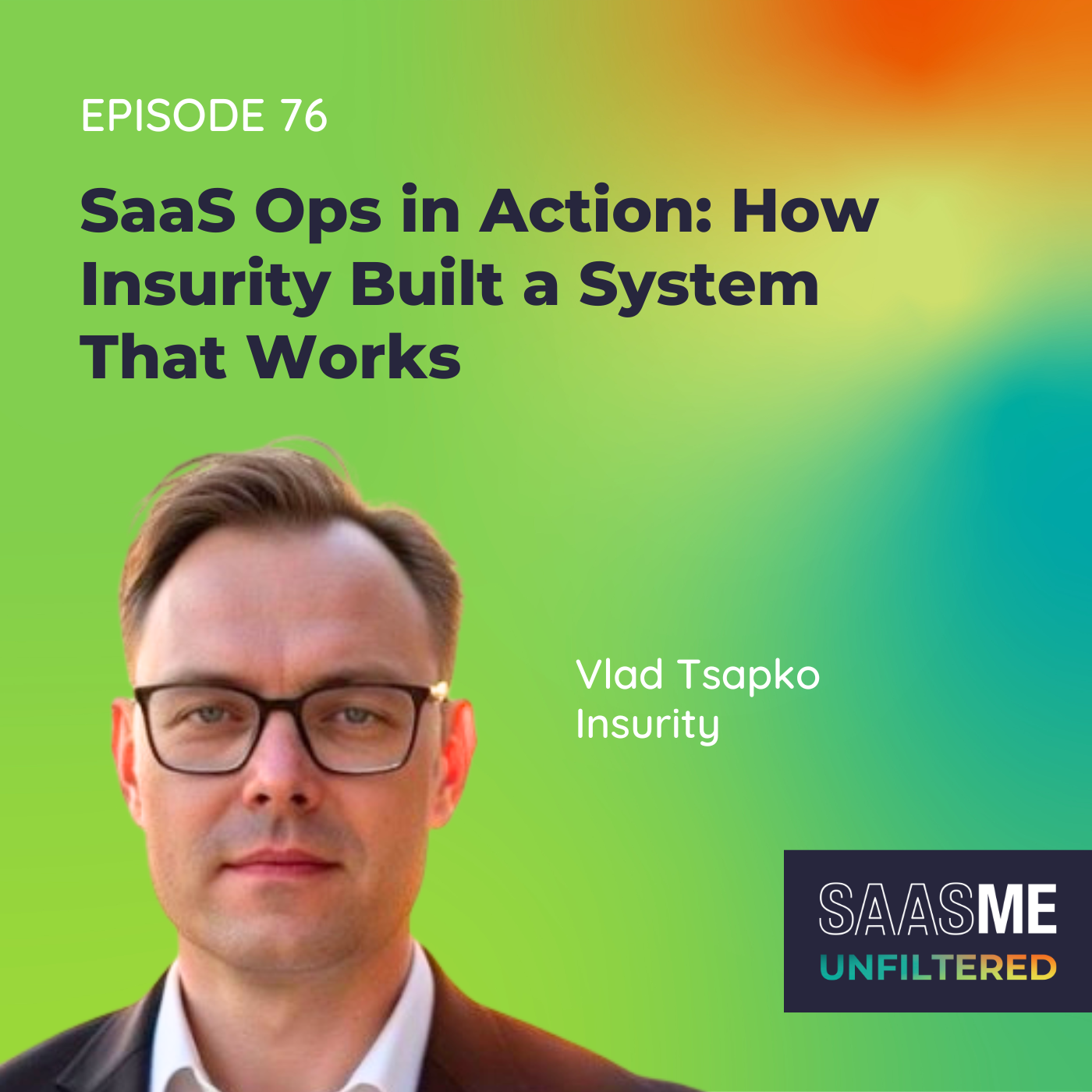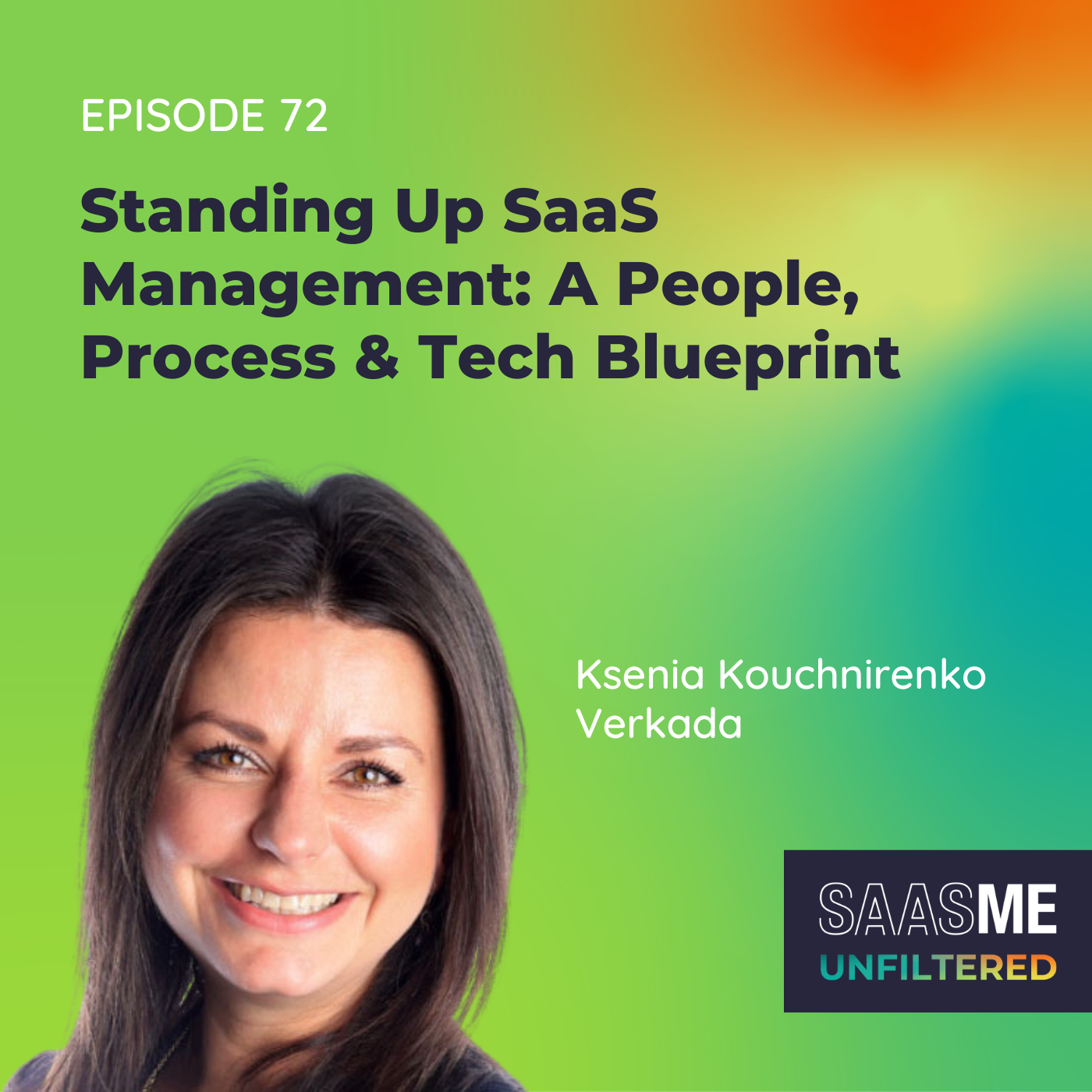Scott Brinker: An Inside Look at MarTech and Its Impact on SaaS Management
- 0.5
- 1
- 1.25
- 1.5
- 1.75
- 2
Scott Brinker: IT needs a framework by which they can support departments like marketing, getting the apps that marketing needs. Marketing is willing to pay for it. Marketing's willing to put in the work, how to actually run and operate this, but they have to fit within a government's framework to make sure that the company remains safe and secure. Yeah, that's trade- off of IT, having that more open framework is marketers absolutely have to adhere into that framework. Otherwise, they're just taking risks that here at 2023 you should not be taking.
Cory Wheeler: Hello, hello, and welcome to SaaSMe Unfiltered, the SaaS Management Podcast, the show with give- it- to- you- straight, real life advice from pros knee- deep in SaaS every single day. SaaS management superheroes just like you. We are back for another episode of SaaSMe Unfiltered. This is the start of our third season. That's a pretty big event for us. I love that we're now entering into that third season. Really excited to have everybody here. I'm Corey Wheeler, Co- Founder and Chief Customer Officer here at Zylo.
Meredith Albertson: Hi, everybody. I'm Meredith Albertson. I'm the Chief Marketing Officer at Zylo. In case you missed it, our bonus episode that we launched at the end of season two on the Zylo SaaS Management Index, I am officially joining the SaaSMe Unfiltered hosting duo with Corey. Super excited about that and I've only been doing this a couple of shows now, but I am taking this as my full opportunity with our first guest of season three to put my fingerprints and my stamps on what SaaSMe Unfiltered is going to continue to bring to our audience. When it comes to SaaS and software, we hear consistently all the time from our customers that line of business teams like marketing are the biggest offenders of buying and spending a lot of money on technology. Trust me, I hear from our IT and our finance team all the time. So, I could not be more thrilled today to invite a guest that I feel can just shed an incredible light and perspective about marketing and technology with all of our IT and finance listeners that we have at the show. Now, I have spent a large portion of my career in B2B SaaS and I have been a fan of our guest for years. He is a Harvard and MIT graduate, started his career as an engineer, then turned entrepreneur founding Ion Interactive, and now he is the VP of Platform Ecosystem at HubSpot. He's also, if that wasn't enough, the editor in chiefmartec.com and serves as the program chair of the MarTech Conference. There is no one better to provide that marketing lens to the SaaS chaos than the godfather of the MarTech landscape himself, Scott Brinker. Scott, welcome to the show.
Scott Brinker: Wow, well, thank you for that very kind intro, Meredith. Anytime someone says that Godfather of MarTech thing, I'm like, " Yeah, that's because we want to A/ B test them an offer they can't refuse." All right. Anyways, great to be here with you.
Cory Wheeler: That's perfect. Scott, I shared a little bit before we started our conversation that you had a really big role in the founding of Zylo. The MarTech landscape really was one of the first illustrations that showed some of the proliferation of SaaS in the marketing space. As we began the company, that was a graphic that we used to early on identify and relate to folks as we started to talk about SaaS sprawl. So, thank you for that.
Scott Brinker: Yeah. Well, I was really happy to hear that. I mean that's also frankly how I got the job I have at HubSpot too is I feel as that landscape started growing, the reaction of a number of the incumbents in the space was fear, uncertainty, and doubt. Oh, my goodness. This is terrible stuff. Stay away, stay away. There's like a new generation of companies that were like, " Okay, well, yes, this is complicated, this is a mess, but can we find a way to harness this?" In the case of HubSpot, really trying to become more of an open platform to work with all these different tools. But yeah, with Zylo here is a SaaS management platform just saying, " Okay, if you're going to have a stack that's going to have a lot of tools in here, make sure that you're able to manage and govern it well."
Cory Wheeler: That's fantastic. So, maybe for some of our listeners that are new to the MarTech landscape, can you give us a brief overview of what it is? I think you just came out with the 2023 landscape as well.
Scott Brinker: Yeah, it keeps growing as our latest one now shows. Boy, it started really humbly. 2011, we published a version that had at the time around 150 different marketing technology tools. The whole point of it originally was marketing was going through this transition of just not having a lot of tech savvy within the department. CMOs, it was just a foreign concept to them. But at the same time, you started to see that more and more of the outcomes that marketers were responsible for were dependent on the toolset that they were using. So, I created the first version of that landscape, not because I had a fetish with logos of SaaS companies, but because I was trying to persuade CMOs to think, " Look at all the tech you're starting to become dependent on. You might want to be investing in some of the people resources to be able to manage this well." What I couldn't have not expected, well I'm sure nobody expected, was year over year that landscape went from a couple hundred to a couple thousand to now well over 10,000. It is an attempt, an increasingly failing attempt to catalog the range of all the different apps that marketers have access to in the different work they do.
Cory Wheeler: Yeah, it's a great visualization of marketing. It's something that inspires us. I think probably everybody has seen an application landscape similar to the MarTech landscape over the last several years and it's proliferated into every single function and within organizations and practice area. So, you've got this visualization of overlap at a micro level. At Zylo here, we think about it at the macro level, which becomes unmanageable completely once you start moving outside of marketing. So, to give that introduction to the episode, you had already explained MarTech has very much exploded in the market. You mentioned over 10,000 tools and counting today. Marketing and to a greater extent, sales, a lot of times when we talk about line of business apps, there's a few different types of apps in most organizations, the big enterprise apps, the smaller individual expense to applications, and then the remainder sits in the line of business. Sales and marketing being huge proponents of automation and digitization and advancing what they're doing, but it makes up a significant portion of your overall SaaS spend. So, now that we are late'22 into'23, we're in the era of responsible growth and this area is under more and more scrutiny. IT experiences budget cuts. Marketing always has a very large budget line item as we all know. So, what we're going to cover in this episode is what that means for marketers who are trying to be better stewards of their own tech stacks, their own budgets, and really ultimately helping them drive toward their goal of driving more revenue. Then we're also going to then spin that and talk about a lot of the personas that are managing software on an aggregate level, IT, procurement, finance, software, asset management, help them understand the thoughts of the marketer and what are they thinking about their tech stack, how can they help them, and what's the impact on buying, managing, and optimizing all of that. So, we're super excited to dive in.
Meredith Albertson: Scott, so I wanted to pull up actually a HubSpot report. You guys recently published reports, The 2023 Marketing Strategy and Trends Reports. Absolutely fantastic. If our listeners have not downloaded it, definitely highly recommend it. There was a stat there that really spoke to my heart. 78% of marketers say that marketing has changed more in the last three years than the last 50. We hit the global pandemic. For marketers, that meant no events, no in- person events. I personally when COVID hit was transitioning in 45 days an in- person event to a virtual experience. Sales isn't doing their in- office meetings anymore. They're not jumping on planes. Companies are trying to figure out, " How do we work remotely? How do we bring hybrid into our culture?" Any playbook that marketing had, thrown out the window, doesn't exist. There's no rules or regulations to this. We were all doing everything and anything that we could to grow the business, to grow revenue, to keep the business moving forward. Now, it's economic uncertainty. Now, we've seen the softening of the economy and we're seeing companies shift from the past three years of this growth at all cost mentality into I think what we're calling the era of responsible business growth, accomplish more with less mentality. How have you seen the shift to smart business growth in the marketing realm?
Scott Brinker: Yeah, it is a great question. It's funny, this changing more in the past few years than it has in 50 years. Everyone in marketing feels that, and it's even pre- pandemic. I think pandemic put it in hyperdrive, but even before then, it was always hard to quantify and I actually find that to be maybe one of the things about the MarTech landscape is that growth over a decade, we can quantify it. It was a growth of 6, 631%. All I would simply suggest is that growth rate is perhaps an artifact that is a shadow thrown a reflection of just how significant all the different changes have been throughout marketing. Then of course, yeah, the pandemic hit and again, all on hyperdrive. I think what's challenging for marketing is they are being... I suppose the negative thing here would be between a rock and a hard place. They have two masters they're trying to serve. One master is exactly what you're talking about, the efficiency. The whole shift of marketing into the digital age had very much brought this idea of performance marketing to the forefront of how marketers run their department, certainly how they're held accountable for their department by senior leadership, but at the same time, marketing is in the business of trying to differentiate from competitors. It's trying to break through an incredibly noisy market. It's constantly where are our customers or consumers shifting and customers and consumers are continually shifting in their expectations and their channels. So, marketers have to chase that. Frankly, a lot of the marketing technology, the reason why marketing technology keeps renewing with so many startups in the space is because these changes of how customers expect to be engaged with or what marketers have to do to reach them where they live is continuing to be evolving. So, when marketers are trying to do this highwire act of like, " Okay, yes, let's standardize, let's simplify, let's make this as operationally efficient as possible. Oh, yeah, I guess we have to be experimenting with this thing and we might have to swap out this with this other thing," that's a really tough balancing act and my hat's off to every CMO who's leading that.
Cory Wheeler: That's fascinating. I'd love to ask, so given that they're serving two masters and it's that shift and you've got to preserve some bandwidth and resourcing to innovate, but you've also got to really tighten things up as you're moving along, how does that change how apps are now being evaluated, how they're being positioned by sales reps, how they're being presented? This shift, does that change for the marketer all of the evaluation and buying process as well?
Scott Brinker: I think so. Boy, again, hats off to you for the SaaS index that you published. So, valuable to see this data, because I mean you know this of course, but anytime you ask people just like, " Oh, how many apps do you have?" I mean, nobody has any clue yet.
Cory Wheeler: They don't know.
Scott Brinker: Until we have to connect it and you're like, " Oh, my goodness." One of the pieces of data I saw on your most recent report was year over year actually, total number of average apps has actually shrunk a bit. So, kudos to you for helping companies get more efficient with that. But at the same time, we see the number of new apps that companies are onboarding each month is actually so quite high. So, you tell me if I'm misrepresenting here, but to me, that's like, okay, there's a churn that's happening here and it's okay to experiment with new apps as long as we make sure we're cleaning up behind us the things that we're not actually using anymore. So, it's interesting. I think this is what always gets people nervous is when you talk to them about MarTech and people start thinking about big things like, " Oh, my goodness, my CRM, my marketing automation platform." Surely, you'd have to be insane to be swapping that out every six months and you would be. That is not the stuff that people swap out very frequently, but if you look at almost this piece layering of there's these enterprise- wide apps, there's like the core departmental level systems of record apps, but you start to go higher up here and you get more and more of these really specialized apps, even apps that maybe only work for a particular individual or a small team. I mean, for instance, we're recording this podcast. I'm not sure what tools you use here, but people can be using things like Descript or StreamYard and there's now all these generative AI things to take the podcast and turn it into bite- size a little bit. These are great tools. Yeah, I mean the valuation process that one goes through of trying something like that is just a qualitatively different experience than, " Okay, we're not happy with our current marketing automation platform. We want to go through a review and analysis process to replace that. What is that migration going to be looking like?" So I just think from the buyer's side, that evaluation procurement adoption cycle is just very different on ends of those spectrums and vice versa. Then for the sellers of these apps, the way they have to engage and support those buyers is pretty different too.
Cory Wheeler: Do you think there's a little bit of a shift towards, and I'm going to use this term and it's not specifically related to cash, but is there more of a focus on ROI and measurement that justify the investment?
Scott Brinker: Yes. Boy, I've wrestled with this forever, because again, marketers being caught between these two masters, very much focused on answering the question of attribution in actual marketing spend, which is a wonderful thing. Of course, anyone who actually does this knows it is-
Meredith Albertson: Painful.
Scott Brinker: ...a bit of a black art. Yeah, it is really hard to get perfect attribution for a whole bunch of philosophical reasons. We don't have perfect data, but I would argue when we think about tool investments, it's even harder. Well, I should say this, there are some tools that you can see a direct line of sight to ROI where if it's something like, " Okay, we're running a series of events, we expect this to do a certain amount of demand generation for us. Here's the performance we're getting working with one particular tool we're going to adapt to a different tool that gives us better ways of doing this. We expect to see a lift in what's happening through that." I mean, there are definitely things you can do where your tool's like, " Oh, yeah, I get that," but then you've got other tools that are these deeper capabilities. I don't know. A great example would be something like project management. Okay. Well, marketers need project management and they need a good way to organize all the different things they're doing. Trying to track that back to a specific ROI, that's hard. I think if you say like, " Oh, well, we're not going to buy any tools unless if there's like this really clear ROI path for it," I think you miss out on some of this deeper productivity capability that's just important to businesses.
Cory Wheeler: Yeah. Well, let me flip that then. So, as you're evaluating a purchase, maybe you're tying it to ROI, maybe you're trying to tie it to metrics or time or something like that, a little bit more to pass muster as you're looking to make the purchase. But are you also looking at taking all the variable products and combining them and going forward with product suites, the old ERP back in the'90s process, get everything onto one system? Do you see marketers going in that direction, certainly not that aggressively but moving to product suites, or still varying up the tooling to meet the specific needs that they have?
Scott Brinker: Yeah, so my opinion on this and I'm biased as you noted, VP of Platform Ecosystem at HubSpot, is I feel like the old narrative in MarTech in the past decade was basically suite versus best in breed. You either get all the tools from one vendor in the box, which is great, because in theory, they all work well together. The downside being like, " Well, you're constrained on what's in that box." You're at then the mercy of how that sweet vendor wants to evolve those things over time versus best of breed. Hey, it's awesome. We can pick any of the favorite tools we love, but now, do we actually get these things to work together? All right, that's hard. When you think about it, both ends of that spectrum suck for different reasons, but they really put marketers in a bad constraint. I think the industry is trying now to move to this true thought of open platforms where you want to pick a major platform. I'll wave the flag for HubSpot as one of the options there.
Cory Wheeler: I like it.
Scott Brinker: That does a lot out of the box. You get a lot of the capabilities that you need. There is very much a universal set of things that we've come to rely on, but it's all open and there's no constraints on other vendors being able to integrate or leverage the APIs. I think you're seeing the industry move away from these models where people have to behind the scenes pay large sums of money in order to get access. No, listen, people want this stuff. They want your core platform. They want an organizing principle, a center of gravity to their stack, but they want the ability to swap in. Hey, we think this other product does this piece of what you do better. So, we love you for everything else, but we want to use this. Or there's this new emerging technology that your team isn't yet even looking at, but it's really important to us in our industry, so we want to be able to move on that. So, I don't know. I'm again biased, but I feel like suite versus best of breed really does need to give way to platform ecosystems.
Meredith Albertson: If you are not unlocking the full value of your SaaS, what are you doing? There is no denying it. SaaS is mission critical to your company's growth and success. As the number two operating expense for most organizations, it's your biggest opportunity to save money and drive efficiency. The time is now to do something about it. Join me and your fellow IT, finance, and procurement leaders at SaasMe. SaasMe is the industry's only dedicated SaaS management event where you can sharpen your skills, hear from your peers, and learn how to unlock value and responsible business growth through smarter SaaS management. Registered today at saasme. com. That's S-A- A- S- M- E. com.
Meredith Albertson: So Scott, I've always loved the concept of best of breed or at least a core foundational platform with almost like a best in breed coating on the outside. I think as so many of these platforms and technologies improve their integrations, it makes that more feasible to have that core center and then being able to, as you just pointed out, to be able to pick those solutions that do that one thing better than the other or that tool you're really attached to. I love the ability for a company to be able to choose the price point or the technology or the feature set that's going to work best for them. But having been here at Zylo for about 14, 15 months now, I've seen the other side of it and witnessing SaaS chaos and how best in breed can really snowball and really become that chaotic environment for a company. In our recent SaaS management index report, we're seeing the average companies adding six new applications every 30 days. That's 72 new applications on average a year. So, how can a company embrace the best of breed approach, get that technology that they really want, but work with the company and their partners in IT and finance to keep that under control? *
Scott Brinker: I've actually been thinking a lot about that stat from yours, and I think there's two interpretations I have of it. One, which is I think the primary case you're making here, is yeah, these things that become duplicative, that basically it's creating negative utilization trends with the stuff you already have, the stuff you get. Yeah, you want pushback on that. I would argue actually, again, a platform ecosystem is a little bit different than what the old school best of breed was. The old school best of breed was almost like, "Yeah, okay, you need that tool for that. Go do that." Often, it's siloed and there were so many problems with these silos. Part of it was yeah, they just weren't sharing data. Workflows across things were a total mess, but also by the very nature of being in different silos, it wasn't unusual then for multiple silos to pop up in the same thing. Yeah, it just compounds the problem on so many levels, financial being just one of many. But to me, the whole point of doing a platform ecosystem is to say, no, no, no. All right. There are different primary functions. We do really want one center of gravity. Part of the governance we're going to put in place is when we're adding new technologies into this, they have to integrate with that core system. Part of that then becomes we're not allowing these silos to get created. Now, this works when you're thinking of it from a line of business departmental type systems. The other side of this, people adding so many apps a month, I mean, you are also tracking things that individuals buy and expense. I found it really fascinating in your most recent index here that the amount of spend on those apps was relatively small. It's like 6%, I think, if I'm remembering correctly, but the total number of apps was massive. It was over a third. It was like 37%. Keep me honest on these figures, but this is how much your index meant to me. I've burned it into my memory. I think that's really fascinating, because that's saying, "Okay, actually, we're not talking a lot of money here," but you've got a lot of individuals who are playing around with different things. My read on it was there's some things they probably shouldn't be doing. For instance, we talked project management earlier. If you have a million project management tools proliferating about your company, I'm no project management expert, but I'm thinking this makes cross collaboration on projects a little bit like the Tower of Babel. But then if you have other things, again, we've talked about the script, this explosion of all these generative AI tools that are really small niche purpose specific tools in a lot of cases, having individuals get some of these and play around with them. How could this accelerate my particular workflow or this particular thing we're doing? I'm not sure that's a bad thing. I actually think that's creative experimentation with those apps on the edge of the organization might actually be a net positive.
Cory Wheeler: This is fascinating. You mentioned governance. Governance is a gross word that everybody hates and you don't want to talk about governance, but governance is a core part of now what is a distributed category and the category being software. Everybody buys across every single line of business. So, you mentioned that, yeah, there should be some governance in place and we've got a lot of different frameworks that we work on with our customers, but do you view governance needs or even demand management? Demand management is, " Should we be buying this as a component?" Do you view that as a key process across all applications? You mentioned project management and others. By the way, every company has a lot of project management tools, or is this an individual software component with shadow IT or the individually expensed apps. Through the lens of the CIO, we hear that sprawl like that, even at the individual level, there's security concerns and then there's employee efficiency concerns, and you nailed it with project management. So, do you view this as a large governance effort or is it more targeted in specific segments?
Scott Brinker: Yeah. Okay. So, in fact, I wrote a post when your report came out here that I'm trying to wrestle through this myself too, of having hopefully a coherent opinion on it, but it's almost like when we look at individual apps, first of all, no disagreement that from a compliance, privacy, security perspective, no one should adopt an app without IT, security, having visibility into this. If they have a whitelist of things like these are okay, these are not okay, if it's a new one you haven't used, you have to let us know about it so we can check it out. I'm 100%. That's like a totally qualitatively different issue. You do not want to be going rogue with this software that way. I think the question of efficiency, that's where I'm like, " That depends." Yes, a million project management tools, probably not efficient from the perspective of the moment you start wanting multiple people collaborating through these things, that becomes a mess. But when I start to look at things like, I mean, pick something like ChatGPT and getting a subscription, I'm not sure if someone's using ChatGPT and someone else's. Yeah, maybe gets access into Google Bard. All right, I guess that isn't charged at the moment, but whatever these things are, I'm not sure that's a bad thing. So, I was trying to think of this framework where what you care about is the net performance, productivity, and profit of the company. The heuristic is almost like if an individual is going to adopt an app, on the whole, does that contribute more to the overall productivity, performance, and profitability of the company, or does it detract from it? I think again, if it's something where actually the individual is just using it for their specific workflow and it actually increases their productivity and their performance, yeah, it's probably a net win. If it's something that like, " Oh, well, you're winning on this side because this person likes this app, but you're losing on this other side because the data isn't matching up with what their colleagues are using over here," it's like that's actually probably a net drag. So, wherever that line is, that's either the thumbs up or thumbs down, but that's probably easier said than done.
Cory Wheeler: Agreed.
Meredith Albertson: Scott, I think it's safe to say after what we've talked about so far, MarTech has exploded. We were chatting briefly before we started today's show about what that 2011 first MarTech landscape look like versus what it looks like today in 2023 and just how insane it is, the number of technologies that are in the MarTech landscape. It's a huge opportunity to optimize and maximize investments for a company. I think certainly a solution to manage all of these tools is critical. In fact, you wrote an article recently on chiefmartec. com that will actually link in the show notes for our listeners, and it was called, " How Big is Your Tech Stack Really?" It was a reaction to the Zylo SaaS Management Index. It's a fantastic article by the way. In it, you said that you think every company should have a SaaS management platform. Now we promise our listeners, we haven't paid you, we're not sponsors. This isn't under the table bribe going on, but that was a powerful statement. Coming from you, Scott, I think our listeners would love to learn your perspective and why do you think that?
Scott Brinker: Yeah, and by the way, I mean if you want to sponsor ... I've answered this, please feel free to get in contact with me. Yes, no, I make this claim free and I don't make this claim about a lot of software, but deep on my blog over the past couple years, there's some other articles where I feel like this explosion of software that's happening throughout tech stacks, you have two games you can try and play. There's the game that we've been trying to play for the past decade or two of consolidation. Oh, no, okay, all these apps, we just need to get rid of this stuff, compress it down into one or two master apps. One ring app to rule them all. We've been trying that strategy for a couple decades now, and I don't know. Scoreboard doesn't seem like that's working too well. So, there's a flip side to this of instead of consolidation, thinking about aggregation, this idea of like, " Okay, listen, we're going to have a proliferation of things, but what we really need are some software tools that help us manage aggregate." I mean, a great example of this would be cloud data warehouses. They're not trying to consolidate down data sources and data applications using stuff. They're trying to say, " Listen, you're going to have a ton of data sources that you need to feed into this warehouse, and then you're going to have a ton of apps that you're going to want to feed that stuff into. Wouldn't a great cloud data warehouse make your life a lot easier?" As a matter of fact, it would. You can go up this stack and you see the same thing with workflow. These workflow automation tools that are designed to say, " Listen, you can have a billion apps here, a billion different things you want to do. That's not going away. Wouldn't it be great to have a tool that lets you orchestrate workflows across all these things?" You're like, " Oh, no. Yeah, actually not a bad idea." I think if you go all the way up to the stack, you get to a governance layer where it's like, listen, our finance and IT and security people, they really would be happier if we could boil everything down to five apps. That just isn't happening. So, what can be tools we can use to aggregate the governance? I think SaaS management platforms like Zylo do an amazing job on a whole bunch of varieties at the time. I mean, there are other tools there too. Something like Okta for single sign- on management, again, what is the value of something like Okta? Well, the more apps that you need a common identity and single sign- on mechanism for, you could argue the more value you get out of a tool like Okta. So, I don't know. This is why I feel like, yeah, SaaS management tools basically flip the narrative and it's like, " Listen, you're not trying to bring the world back to the day where it's just Microsoft Office and that's it." We're going to live in a world of very rich and ever- changing tech stacks. So, now what you need is you need a solution that's going to make that manageable for you, governable for you.
Cory Wheeler: Yeah, fascinating. Because when we talk to our customers today, Scott, similar to a CMO, who is looking to sometimes be able to articulate the ROI of the work that they're doing, that's the golden goose that they're always chasing, CIOs want to measure the value of these applications internally. I think that's part of what you are getting at, adoption of products, enabling their users, providing a better employee experience. Once you've got that visibility, then the CIO and CFO are able to start to map that value story and implement change to increase value to these expensive solutions that are driving outsized returns for their business. So, do you view it that way that if you've brought everything together, everybody needs a SaaS management tool, that it's not about cutting and cut, cut, cut? It's also and probably more so about getting more value and creating that visibility around the apps that you have. Would you agree with that?
Scott Brinker: Yeah, absolutely. I mean, again, it would be the same thing like a cloud data warehouse. The analogy would be if you really do just dump data in there and you have no meta structure, I mean, you've got the tool, but you're not really getting the value out of it. I mean, if you just hook up a SaaS management platform and then you're like, " Hey, listen, here's a number of how many apps. Isn't that cool?" It's actually using this to say, " No, let's optimize how we're using this stuff. Let's get more value out of that stuff." Yeah, I think it's great. I think you're in a very safe position that you could argue if you were remarkably good at your job and you could help companies consolidate everything down to one app, it would actually put you guys out of business. But I think you walk in a pretty good balancing line of like, " Listen, you're going to have a rich tech stack, but there's no reason why you shouldn't have an efficient and effective rich tech stack."
Cory Wheeler: Agreed.
Meredith Albertson: I love that, efficient and rich tech stack.
Scott Brinker: I guess I'm becoming your spokesperson.
Cory Wheeler: Here we go. Come on.
Meredith Albertson: I know. We're going to have to get the contract ready after we finish up today. We're going to put you on billboards next.
Scott Brinker: Keep publishing your index. Yeah, it's such a valuable resource to the industry.
Meredith Albertson: Well, thank you so much for that, Scott. So, Corey just a minute ago said, " Cut, cut, cut," which I think is a great transition into what my next question was is all companies are trying to save money and drive efficiency. It's the headlines right now. It's what we're all taking webinars on and talking to our different resources about. How do we do a better job of that? I have seen this firsthand. Scott, I'm sure you've been hearing a lot about this too, and we're hearing this in the marketing community. Marketing program spend and marketing headcount is often one of the first places that companies go to make cuts. Those are big program spends. Let's go cut marketing, and it's a big conversation. It's weighing heavily on a lot of marketing leaders right now, because it's still deliver more pipeline, help grow the company, but do it with less. I'd love to know if you have thoughts or advice on what are other ways that companies can look to reduce that cost without immediately going in and slashing the marketing budget or slashing the marketing program spend?
Scott Brinker: Yeah, I mean, it's hard. This is in theory, if you put in place the right technology and the right data, hopefully you're getting the analytical insight to help feed that decision, because yeah, marketing is a portfolio of many, many different things we do as best as we can. We try and attribute ROI to those things, and it's always a range of old standbys. We know that just work consistently, think we're running that a little bit more experimental. So, when you enter into a budget crunch, yeah, I don't know that there's a magic bullet here. It's almost like you have to look at that portfolio and stack rank it and say, " Yup, these are the things we really can't live without now. They're worth it." These interesting fun stuff, we should come back to this, but yeah, we'll do it when the sun is shining again. That's never easy. But I think it's really interesting times right now on this performance question because we are entering a place here where some of these generative AI technologies have the potential to actually change quite significantly the ratio between where we've been investing in human resources and what we can get out of the technology. I'm not a doom and gloom person on this. I actually think for the very reason of what you guys know so well, the orchestration of things is where all the magic happens. The individual tasks have value, but it's the orchestration where companies live and the AI isn't solving that for us anytime soon. But when you do look at individual program execution, content marketing is probably the biggest example. There's just some of these things where it's very clear that this current generation of generative AI tools is going to change the ratio of technology to people and how we do things. So, it'll just be interesting to see, particularly in this environment, where that change is happening and how marketers start to rebalance that portfolio between tech investment and people investment.
Cory Wheeler: Tech investment and people investment and other important investments. In 2022, we saw the economy soften, but lead gen tools, that very much continued to accelerate and that still feels like a growth at all cost approach. But does the increased spending in the apps that you've stack ranked that matter in the moment, does that leave you enough money left over, enough investment, enough capital resourcing for your critical marketing programs like digital ads and podcasts and events and things like that? Do you feel like there's a trade- off that has to happen right now?
Scott Brinker: You're trading off across the whole portfolio. I don't think there's a one- size- fits- all answer to that. Again, if anything, it comes back to kudos to those marketers who invested in getting the right data mechanisms in place, to have the analytics, to have actually informed opinion of where they should or shouldn't make those cuts. It doesn't make it any easier.
Cory Wheeler: Sure.
Scott Brinker: But at least, yeah, you've got some data to drive that decision.
Cory Wheeler: Very interestingly enough, to this point of cuts and where do you invest, we are seeing a contraction in our customer tech stacks, and you mentioned that at the outset as well. In 2023, the average organization had 291 applications, the average, and spent about$ 50 million on software as a service compared to 323 and $60 million the year before. Pretty large drop there. This shows that organizations that are prioritizing SaaS management can definitely streamline their portfolio and utility and cut back on spend, but there's still a ton of waste on licensing, underutilized licensing. I was astonished even as a co- founder of a company looking to address this, that the numbers that we saw from our customer base very early on and still hold true today, today that number is 44%. Over a 30- day period, 44% of the licenses inside your company today are going unused. So, how do marketing leaders look at that and how do you ensure your team is maximizing those investments that are on now the prioritized critical tools, and how do you really drive that as a marketing organization?
Scott Brinker: Again, this is one where I feel like there's two sides to this. So, I think there's the mainstream argument that of listen, if you can identify that, for instance, like seats still a very popular pricing model for a lot of SaaS, if you can identify seats that are unused and basically remove them, why wouldn't you? I think the only place where there's these exceptions to the rule is cases where you have a set of users who are like, " Yeah, this is every day, they're using this. You're going to see their utilization." Anyone who's in seat has a license, utilization is going to be pegging the needle. But then very often some of these tools have folks who need to contribute or participate in a much more limited way or on a much more occasional basis. I think of a good example of something like a sales enablement tool. Hopefully, if you've set it up right, your salespeople on the seats that they have for that are going to be in that pretty much every day, certainly every week. But you might have marketers who don't use it on a daily basis, but part of what they do as part of different programs and campaigns, they're like, " Oh, yeah, we have to log in here. We have to feed the data. We have to get things set up." Then they're out and they move on and other things for a while. So, those become seats that you're like, " Well, okay, we're not utilizing that quite that way, but is it still probably worth it?" So it's just making sure you're not throwing the baby out with the bathwater. That when you do the seat compression, you just really understand, " Hey, is there a legitimate use case for any individual to have a seat? If so, hey, if it's worth it, do it." But yeah, getting rid of the zombie seats seems like, okay, that's a nice way to go directly to the bottom line.
Cory Wheeler: That's great. That's actually a term we use internally, zombie applications and seats. So, nicely done.
Scott Brinker: Hey, zombies, they're all there.
Meredith Albertson: Scott, I want to switch a little bit here and talk about shadow IT. I know that you've got some really thoughtful opinions here that I wanted to dig in a little bit. When I was looking to join Zylo, I had a lot of questions about the tech stack. What are the tools that Zylo was using? I think naturally a lot of marketing leaders are interested in that. They want to know what tools we're going to be able to use to empower the team. Naturally, with so much MarTech to choose from, people end up with their favorites. I'm guilty of that, 6sense, Casted, Metadata, Canva, some of my favorite tools. When marketers change jobs, I think we can become very passionate about the tools that we love and we want to bring them with us. Maybe we can't get approval through the right channels. We go out, we put it on our credit card, we expense it, and we go. At scale, that starts to really cost some problems within the organization and it results in a tremendous amount of tools for one team. What challenges are arising for marketing teams around what I can see really as developing an inefficient tech stack?
Scott Brinker: Yeah. Oh, this is a fun question. Part of the reason I have an allergic reaction to the phrase shadow IT is because it goes back over the past 10, 15 years, where essentially IT had no interest in really advancing the state of digital marketing at the pace digital marketers did. This is a whole thing that created the MarTech stack is marketers just weren't being served by the IT org and they had to build their own. Otherwise, they just couldn't do their job. This created a lot of turmoil. So, it was very often like, " Oh, well, the marketing department, that's shadow IT." I always felt like there was the opposite side of that. Have you considered the possibility of shadow marketing? That basically when IT makes decisions about limiting what marketing can do or limiting how customer experience is going to work, they're actually affecting the brand of the business. They're affecting the efficiency of the marketing organization. That's shadow marketing. Anyways, all right. So, that argument, as you imagined, probably didn't fly very well with most CIOs, and I'm sure the CIOs listening now are like, " Yeah, got up." But I think we've got into a place where, I mean, it shows in your report, this idea of having departments take responsibility for the apps that are really specific to their organization, but to do it in a way that's very visible to IT. It's going through the proper compliance and security reviews. That's right. I think we've gotten a place where now people don't consider that shadow IT. What seems like if there is a legitimate shadow IT, it's what you were saying here of like, " Oh, well, someone's trying to get an app either as an individual or if they're truly a rogue departmental leader," that they're saying like, " No, no, no, we don't want IT security. We don't want to have to worry about compliance." Well, sorry, it's 2023. You just can't do that. We see so many headlines every single week of companies getting in trouble over GDVR and other privacy regulations or cybersecurity things where data's been exposed and talk about brand damaging things. I mean, that's just terrible. So, I don't know. I feel like IT needs a framework by which they can support departments like marketing, getting the apps that marketing needs, marketing's willing to pay for it. Marketing's willing to put in the work how to actually run and operate this, but they have to fit within a government's framework to make sure that the company remains safe and secure. Yeah, the sort of trade- off of IT having that more open framework is marketers absolutely have to adhere into that framework. Otherwise, they're just taking risks that here in 2023, you should not be taking at this point.
Meredith Albertson: Yeah, there's no reason to let a$ 10 app cost you$ 10 million in fines.
Cory Wheeler: Scott, this has been amazing. I feel like I've learned a lot. I love your energy and passion. I share that in our space as well. So, I think we're a little kindred here, but I'm very excited to jump to our last section of the show. It's a little word association and rapid fire. I'm going to throw out a word, Meredith's going to throw out a word, and I'd love your first reaction to it. It could be a word. It could be a sentence.
Scott Brinker: Oh, goodness. I'm going to get myself in so much trouble here.
Cory Wheeler: Yes. That's what we try to entrap everyone on the show. So, are you ready?
Scott Brinker: As ready as I'm going to be.
Cory Wheeler: Right. First one, ChatGPT.
Meredith Albertson: Red Sox.
Scott Brinker: Bing, better than Yankees. Oh, man, I'm in so much trouble.
Cory Wheeler: It took a little bit for that one to come out. Summer.
Scott Brinker: Finally.
Meredith Albertson: The MarTech landscape.
Scott Brinker: Big.
Meredith Albertson: Love it. Well, Scott, man, I know Corey said it. Thank you so much for being our first guest, season three. It's a big moment here for us on SaaSMe Unfiltered. The line of business perspective is critical to our IT, SAM, finance leaders. It's incredibly important that they understand this. We appreciate you taking the time out of your day. Thank you for joining. For all of our listeners, if you'd like to read more by Scott, please go to chiefmartec. com. Again, we'll put that in the show notes for you and can read some more of his incredible content. Again, Scott, thank you so much.
Cory Wheeler: Thank you, Scott.
Scott Brinker: Thank you so much for having me.
Cory Wheeler: Did you enjoy the episode? Pass it along to your friends, subscribe to get notifications for the latest episode, share your favorite takeaways, and join the conversation on social media using# saasmeunfiltered.
DESCRIPTION
From addressing ever-changing market conditions to driving business growth, marketing teams are often buying new and expensive software. Naturally, it’s important for them to be good stewards of those investments. At the same time, IT and Procurement must understand how marketers are thinking about their tech stack and the impact it has on buying, managing, and optimizing SaaS. In this episode, Scott Brinker, creator of the MarTech Landscape, weighs in on SaaS trends and what he sees ahead for MarTech.
Key Takeaways:
- [00:00 - 03:11] Introduction to Scott Brinker
- [03:13 - 04:19] Scott and the landscape of SaaS management
- [04:21 - 06:21] An overview of the MarTech landscape in 2023
- [06:29 - 07:51] Being better stewards of your own stacks
- [07:53 - 11:45] The 2023 Marketing Strategy and Trends Report, quantifying growth and shifting to meet the demands of the modern age
- [11:49 - 14:46] How apps are being evaluated, and Zylo's SaaS Index
- [14:46 - 16:35] It's really hard to get perfect attribution in marketing and ROI
- [16:39 - 19:10] Searching for centralized services for tools, or navigating multiple vendors
- [20:09 - 24:19] Embracing the best of breed approach, considering primary functions
- [24:20 - 27:35] Governance and software adoption
- [27:36 - 31:26] Scott talks about his article "How Big is Your Tech Stack Really?" and the value of key pieces of software
- [31:27 - 33:38] Chasing the Golden Goose of ROI, optimization
- [33:41 - 36:39] Saving money and driving efficiency, finding the right technology
- [36:39 - 37:43] Tech investment and people investment, does there have to be a trade-off?
- [37:44 - 40:43] Cuts and where to invest, and exceptions to the rule with utilization
- [40:41 - 44:36] Shadow IT and advancing the state of digital marketing
- [44:36 - 46:02] Rapid fire & closing
Today's Host

Ben Pippenger

Cory Wheeler

Meredith Albertson
Today's Guests








